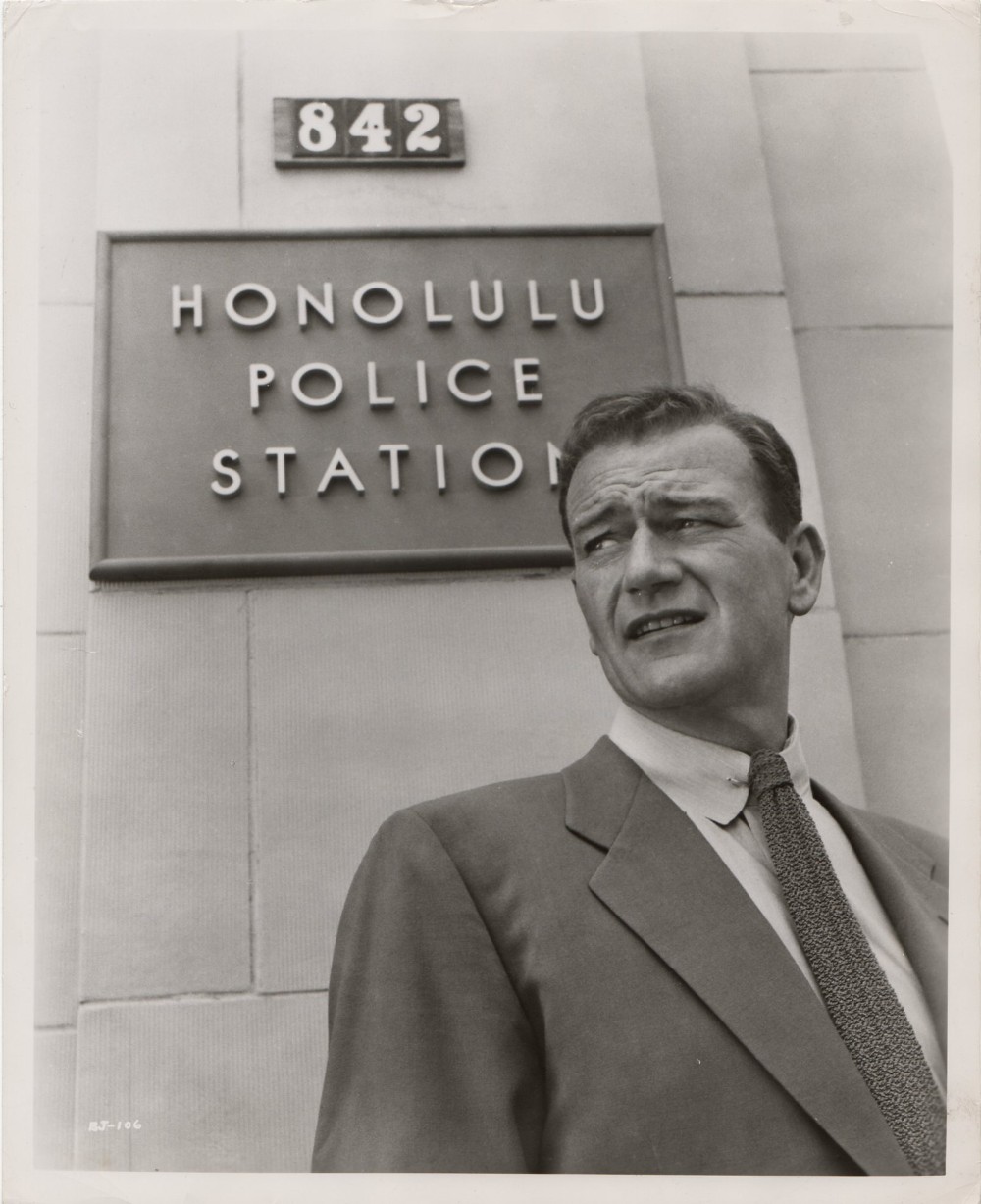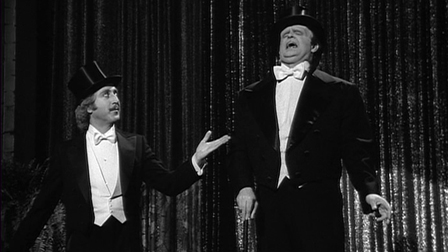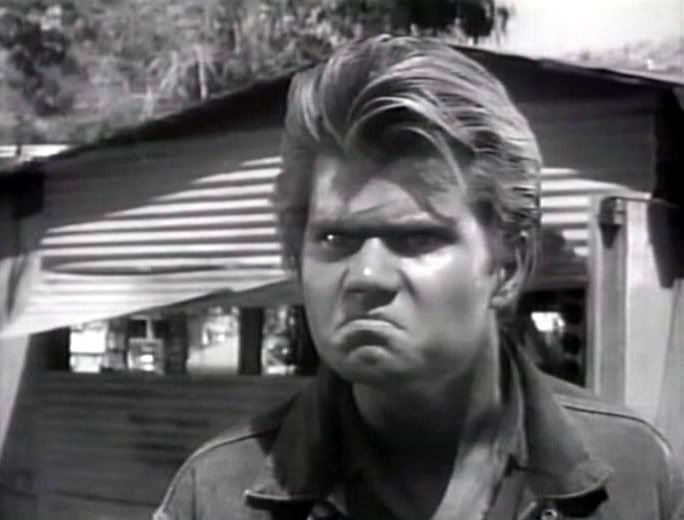A Guide to the Interesting and Unusual on TCM
By Ed Garea
July 24
11:45 am Big
Jim McLain (WB,
1952) – Director: Edward Ludwig. Cast: John Wayne, Nancy Olson, Jim Arness,
Alan Napier, Veda Ann Borg, & Hans Conried. B&W, 90 minutes.
It wasn’t one of the Duke’s better films. Truth be told, it’s as
dull as dirt. But, it comes to us as a fascinating and hilarious relic of a
lost era in the wacky history of this country. During this era, known by many
as The McCarthy Years, the most popular sport, judging by this movie, is Commie
Hunting. And no one hunted Commies better than the Duke. Here, he and Arness
play HUAC investigators sent to Hawaii to hunt Commies in Paradise. There’s
only one thing wrong with this premise: The Communist Party was a legal
political party, and it was not a crime to belong. But when have technicalities
such as this stopped the Duke?
Scenes to look for in the film: (1) the fight in the restaurant.
The extras simply stand and gawk instead of acting in the scene as extras. (2)
The scene where the parents turn in their son as a Commie, the logic being that
he’d be better off in prison than running around with his pinko pals. To sum
the film up, it’s apropos to paraphrase the Duke himself: this movie is
re-godamn-diculous.
Trivia: In Germany, the film was dubbed and titled Mathuana,
and features the Duke as a hunter of marijuana smugglers. That makes more sense
than the original.
2:00 am Young Frankenstein (20th Century Fox, 1974) –
Director: Mel Brooks. Cast: Gene Wilder, Madeline Kahn, Marty Feldman, Teri
Garr, Peter Boyle, Cloris Leachman, & Kenneth Mars. B&W, 106 minutes.
It could well be argued that this was Brooks’ best film; it
certainly holds up better today than madcap frolics such as Blazing
Saddles and History of the World, Part 1. Young Frankenstein is a loving tribute to the Universal horror
films of the ‘30s, taking equally from Frankenstein (1931), The
Bride of Frankenstein (1935), and Son of Frankenstein (1939).
The beauty of the film lies in its thorough knowledge and respect for the
originals while realizing that by tweaking and exaggerating some of those
original scenarios, it would bring out their more ridiculous aspects. I could
go on and rave about the virtues of this film, but I’d only be preaching to the
converted. Too bad TCM is screening it at this ungodly hour, but it appears
regularly on the Fox Movie Channel.
Trivia: The last line spoken by “hermit” Gene Hackman as the monster
flees – “Wait. Where are you going? I was going to make espresso” – was an
ad-lib on the actor’s part. Brooks laughed so hard that he ruined the first two
takes, so the line was rehearsed until Brooks could film without laughing.
July 25
6:30 am The Black Room (Columbia, 1935) – Director: R. William
Neill. Cast: Boris Karloff, Marian Marsh, Robert Allen, Thurston Hall, John
Buckler, & Katherine DeMille. B&W, 75 minutes.
One of the most underrated and overlooked actors in the history of
cinema surely has to be Karloff. Typecast and pigeonholed ever since he donned
the makeup to play Frankenstein’s monster, Karloff was a marvelous actor, at
home in comedy or drama. So what could be better than one Karloff? Why, two
Karloffs, of course. In this thriller, Boris plays twins who couldn’t be more
opposite. Their family is plagued by a curse which states that one of the twins
– the good Anton – will kill the other in the “black room,” one of those mysterious
rooms in the family castle. Gregor, the local Baron, is a lout, a serial killer
hated by the townsfolk. Finally fed up with his antics, the villagers stage a
mob scene and storm Gregor’s castle. Suddenly Gregor decides to abdicate and
leave the governing to his twin, Anton. Will Anton kill his brother in the
black room? Tune in and find out. Not only will you see a great thriller, but
also one of the most nuanced performances an actor (Karloff) can give.
11:15 am Dead Men Walk (PRC, 1943) – Director: Sam Newfield. Cast:
George Zucco, Mary Carlisle, Dwight Frye, Nedrick Young, & Fern Emmett.
B&W, 64 minutes.
If anything, Zucco could be said to be the biggest star on the PRC
lot, which isn’t saying much. But he was the only actor who had his own
trailer; even if it was one of those small “birdhouse” teardrop trailers pulled
by an automobile. A trailer is still a trailer – and a sign of prestige. Zucco
also plays twins, and one is evil while the other is good. The evil one, Elwyn
Clayton, is a devotee of black magic, while the other Lloyd Clayton, is a
small-town doctor, beloved by his patients. Elwyn returns from the grave
through the power of black magic as a vampire and is out to get his good twin.
For all this, it’s a rather toothless chiller with one somewhat redeeming aspect:
Frye, who steals what’s left of this picture as Elwyn’s maniacal underling,
Zolarr. Watch it for him alone.
Trivia: This is the final film appearance of Carisle, who once had a
promising future when she was named as a WAMPAS Baby Star in 1932. But her film
career never really took off and by the ‘40s she was relegated to working in
Poverty Row productions. She retired shortly after the film wrapped and married
actor James Blakeley, who went on to become a production executive at 20th Century
Fox.
4:00 am The Explosive Generation (UA, 1961): Director: Buzz Kulik. Cast:
William Shatner, Patty McCormack, Lee Kinsolving, Billy Grey, & Steve
Dunne. B&W, 89 minutes.
What’s better than Shatner playing a teacher in a low-budget
drama? Why, Shatner teaching sex education to teenagers, of course. McCormack
is Janet, a high school senior who spent the night at boyfriend Kinsolving’s
beach house rather than risk losing him. The next day she asks her – and
everyone’s – favorite teacher to give them lessons in sex education. His
solution? To have the students write anonymous essays on the subject that could
be read and discussed later in class. Needless to say, this results in an
uproar once parents get wind of what’s going on. When Shatner is ordered by the
school’s principal to burn the essays, he refuses and is suspended. This leads
in the students staging a massive “silence strike.” What the hell, it’s fun,
it’s cheap, and it stars Shatner. That’s three good reasons to watch.
Trivia: It’s director Kulik’s first feature film. He worked mainly
in television, and directed the classic Brian’s Song, as well as
the cult fav Bad Ronald.
July 27
12:00 pm Curse of the Mummy’s Tomb (Hammer, 1964) – Director: Michael Carreras.
Cast: Ronald Howard, Terence Morgan, Fred Clark, Jeanne Roland, & George
Pastell. Color, 81 minutes.
Hammer struck box office with their 1959 remake of The
Mummy. They had five years to come up with a sequel and they give us this
less than stellar entry in the genre. None of the original stars returned, and
neither did the story. We are given an entirely new mummy and scenario, with a
little twist. It seems that one of the participants in the expedition is
actually the mummy’s brother, who was cursed with immortality for having killed
his brother. And, of course, he’s after the reincarnated princess of his
dreams. The film starts strongly, but drags in the middle before giving us a
good schlocky ending. Clark is the American star, playing the financial backer
of the expedition who wants to take the exhibits on tour instead of donating
them to a museum.
2:00 am Wild Guitar (Fairway-International, 1962) – Director: Ray
Dennis Steckler. Cast: Arch Hall, Jr., Arch Hall, Sr., Nancy Czar, William
Watters, Cash Flagg, & Marie Denn. B&W, 87 minutes.
Hall, Jr. stars in this cheesy piece of schlock about a young
guitar whiz who gets a big break on a local TV show. An unscrupulous record
producer (Hall, Sr.) signs the youngster and then proceeds to bilk him out of
his earnings, until he finally catches wise and dumps the crook. Directed by Steckler,
who appears in the film under the billing of “Cash Flagg” as Hall, Sr.’s skeevy
assistant, directed, and the film has all the Steckler touches we’ve grown to
know and not necessarily love: the strange musical interludes, the badly-staged
fights that lead to an equally ridiculous bash-at-the-beach finale, stupid henchmen,
plus the brainless dialogue. The buzz about the movie is that Hall, Sr.
financed it to get Junior a foothold in the recording industry. He should have
saved his money.
3:45 am The Sadist (Fairway-International, 1963) – Director:
James Landis. Cast: Arch Hall Jr., Helen Hovey, Richard Alden, Marilyn Manning,
& Don Russell. B&W, 94 minutes.
Three schoolteachers on their way to a Dodgers game are waylaid
and terrorized by teenage serial killer Charlie Timms (Hall, Jr.) and his
equally depraved girlfriend, Judy (Manning). Loosely based on ‘50s thrill
killers Charlie Starkweather and Caril Fugate, this is actually a decent, taut
thriller with stellar performances by both Hall and Manning. Credit the
director, who came to the producer (Arch Hall, Sr.) with a script he had
written, and credit Hall, Sr. with the good sense to allow Landis to direct
instead of plugging in his usual idea of a director – Ray Dennis Steckler. The
results are impressive and the film holds up well today.
Trivia: It could be said that the real star of The Sadist was its
cinematographer, Vilmos Zsigmond. A refugee from Hungary, he began in America
by photographing B and Z-grade films, where he earned a reputation for his excellent
camerawork, which often times was far superior to the crap he was filming. He
would later come to helm such A-productions as McCabe and Mrs. Miller, Deliverance, The
Long Goodbye, The Deer Hunter, and Close Encounters of
the Third Kind.
July 28
2:00 am Ugetsu Monogatari (Janus, 1953) – Director: Kenji Mizoguchi. Cast:
Machiko Kyo, Masayuki Mori, Kinuyo Tanaka, Kasae Ozawa, & Mitsuo Miko.
B&W, 96 minutes.
As I stated once before, Samurai films are Japan’s Westerns, and
this is one of the very best. The film is based on two stories by the 18th century
writer Akinari Ueda from his collection Ugetsu Monogatari (Stories
of the Moon and Rain), and takes place during a civil war in 16th century
Japan. Two peasants – Genjuro (Mori), a potter who hopes to make his fortune
selling wares; and Tobei (Ozawa), who wants to become a samurai – have left
their wives behind in the village. However things do not work out as they
planned. Although he does well financially selling his wares, Genjuro is
seduced by a mysterious noblewoman named Lady Wakasa (Kyo), of who it could be
said that she is not what she appears. Tobei, on the other hand, does realize
his goal of becoming a samurai, but he does so through deceit. Meanwhile, the
rebel army attacks their village and their families just manage to escape, but
both Genjuro and Tobei will later realize the price that is to be extracted for
their ambition and deceit.
This is a sumptuously-filmed drama resting on the simple premise
of what happens when one tries to prosper through trickery and deceit,
forgetting the values that hold his family together. The theme here is the
emptiness that results when one betrays his traditional values and Mizoguchi
captures this mood brilliantly, even to the point of where the cinematography
threatens to overcome the story itself. But keep riveted on that story – it’s
one for the ages.
July 31
4:30 pm 5 Against the House (Columbia, 1955) – Director: Phil Karlson. Cast:
Guy Madison, Kim Novak, Brian Keith, Alvy Moore, Kerwin Matthews, & William
Conrad. B&W, 83 minutes.
It would seem that we’re going from the sublime to the ridiculous,
but don’t let the title fool you. This is an excellent caper film about four
veterans attending college on the GI Bill who pool their resources and join up
with cabaret singer Novak to plan the perfect crime – the robbery of a Reno, Nevada,
casino. Directed by Karlson, the film keeps the viewer’s attention not only
with Novak, but also with the tightly-constructed and developed plot, making
the robbery of the casino seem not like a bolt from the blue, but the result of
solid logical planning. Martin Scorsese has stated in interviews that Karlson’s
little caper film was a major influence when he directed Casino.
Caper films are always fun, and when directed by a pro such as Karlson, are
definitely worth viewing.
Trivia: The film was originally assigned to Frank Tashlin, who did
much of the pre-production planning, but Karlson stepped in when Tashlin
abandoned the project for the chance to direct Dean Martin and Jerry Lewis in Artists
and Models.
For other Cinema Inhabituel films, click here.

_02.jpg)












